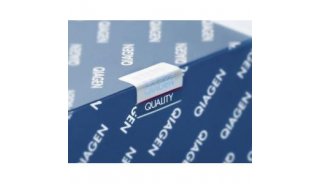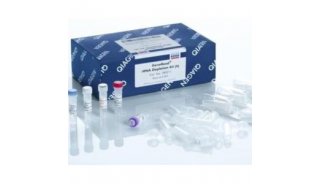Dynabeads® Co-Immunoprecipitation Kit
实验概要
The Dynabeads® and buffers provided in this kit will enable you to a) covalently immobilize antibodies of your choice onto the surface of Dynabeads, and b) use the antibody coated beads for co-immunoprecipitation. This kit is intended to be used for the co-immunoprecipitation of proteins, intact protein complexes, intact protein-nucleic acid complexes, etc. The antibody coated Dynabeads surface has ultra-low background binding, thus does not require blocking prior to use. The protein to bead interaction occurs directly on the bead surface; this enables the ultra rapid procedure that permits isolation of even labile composites, and allows isolation of complexes of all sizes (i.e. no upper size limit). This kit is designed for and tested with cultured yeast and mammalian cells and is compatible with tissue, insect, bacteria, and other lysates. For best results, please read through the manual carefully prior to start.
实验原理
Antibodies (Ab) of your choice are covalently coupled to Dynabeads. Once antibodies have been coupled to the Dynabeads, the bead-bound antibody may then be used for co-immunoprecipitation experiments. Captured proteins and protein complexes are easily separated from lysate using magnetic separation properties of Dynabeads. Magnetic separation facilitates washing, buffer changes, and elution. Antibody-to-bead coupling works optimally with purified antibodies, although the coupling reaction also works well with antibodies in storage buffers that include protein additives (e.g. BSA) and/or sodium azide (NaN3). This kit is not recommended for use with antibodies that have been stabilized in glycerol.
主要试剂
Dynabeads® Co-Immunoprecipitation Kit
Magnet: e.g. DynaMag™-2
Mixer allowing rotation or tilting of tubes.
Antibodies of your choice.
实验步骤
Day 1
1. Weigh out the appropriate amount of Dynabeads® M-270 Epoxy
Moisture on unused beads will deactivate the reactive groups necessary for covalent antibody coupling. To avoid condensation on unused beads, make sure the beads are at room temperature prior to opening the bottle.
2. Wash the beads: Add 1 ml of C1 to the beads and mix by vortexing or pipetting.
3. Place the tube on a magnet and allow the beads to collect at the tube wall. Remove the supernatant.
4. Add the appropriate volume of antibody C1 (according to Table 1) to the washed beads and mix by vortexing or pipetting.
Example: If you are coupling 5 mg Dynabeads and your required quantity of antibodies has a volume of 100 μl, you will need to add 150 μl of C1 (i.e. 250μl C1 – 100μl Ab = 150μl.)
5. Add the appropriate volume of C2 and mix by vortexing or pipetting.
6. Incubate on a roller at 37°C overnight (16-24 hours). Make sure the fluid in the tube is mixing well. Make sure the beads do not settle. Beads settling during the overnight incubation will result in inefficient antibody coupling.
Day 2
7. Place the tube on a magnet. Allow the beads to collect at the tube wall. Remove the supernatant.
8. HB Wash: Add 0.8 or 1.6 ml of HB and mix by vortexing or pipetting. Place the tube on a magnet, allow the beads to collect at the tube wall, then remove the supernatant.
9. LB Wash: Add 0.8 or 1.6 ml of LB and mix by vortexing or pipetting. Place the tube on a magnet, allow the beads to collect at the tube wall. Remove the supernatant.
10. Short SB Wash: Add 0.8 or 1.6 ml of SB and mix by vortexing or pipetting. Place the tube on a magnet, allow the beads to collect at the tube wall, then remove the supernatant. Repeat the wash once more.
11. Long SB Wash: Add 0.8 or 1.6 ml of SB and mix by vortexing or pipetting. Incubate on a roller/rotator at RT for 15 minutes. Place the tube on a magnet, allow the beads to collect at the tube wall, then remove the supernatant.
12. Resuspend beads in the same volume of SB as was the total coupling reaction volume and store at 4°C until use. The final bead concentration is 10 mg antibody coupled beads/ml. Your beads are now covalently coupled with antibody and ready for Co-IP.
注意事项
1. Scale of Co-Immunoprecipitation
Co-immunoprecipitation for detection with Western blotting or silver staining methods requires 0.05 g to 1.5 g of cell sample and 1.5 mg of antibody coupled Dynabeads (when using 5 to 7 μg antibodies per mg beads as recommended in the Antibody Coupling Considerations section). For co-immunoprecipitation for detection with Coomassie staining or for Mass Spectrometry analysis, 1 g to 15 g (and in some rare cases up to 25 g) of cell sample and 7.5 mg of antibody coupled Dynabeads are necessary. Note that the same amount of antibody-coupled beads is used despite varying amount of cell sample. For high abundant proteins, use the low scale of the cell sample recommended. For low abundant proteins, use the upper scale of the cell sample recommended.
2. Co-Immunoprecipitation Buffer System
The co-immunoprecipitation buffer system provided in this kit has been optimized to achieve isolation of intact protein complexes while minimizing non-specific binding.
3. 5 × IP
For co-immunoprecipitation, the cell sample needs to be resuspended in an Extraction Buffer (see Section Co-Immunoprecipitation Optimization below) from which the desired protein complex is isolated. The Extraction Buffer is made with 5 × IP supplied in the kit. The 5 × IP is supplied as 5 × concentrate and in sufficient quantity to allow for 40 coimmunoprecipitation reactions using up to 1 g cells, or 8 reactions using up to 7.5 g cells. For reproducible results, it is imperative that a 1:9 ratio of cell sample to Extraction Buffer is used for the co-immunoprecipitation each time; e.g., 0.5 g cells needs 4.5 ml Extraction Buffer. (Note that cells should be weighed with as much liquid removed as possible)
Example: Weigh the empty tube in which the cell sample is to be collected. Do not assume an average weight of the tube. Centrifuge the cells in the tube, remove as much of the liquid as possible from the cells. Weigh the tube again. Calculate the weight of the cell pellet. [Weight of tube Cells] – [Weight of empty tube] = Weight of cells
Different protein complexes require different Extraction Buffer composition for successful co-immunoprecipitation. Currently there are no rules allowing prediction of buffer composition needed for isolation of particular protein complexes. The optimal buffer composition needs to be empirically determined. For instance, some protein complexes require the presence of DTT and/or MgCl2 to remain intact, while in other complexes these modifiers will disrupt the complex and/or increase non-specific binding. Increasing concentrations of salt and detergent in the Extraction Buffer will generally increase the stringency of the co-immunoprecipitation. To isolate intact protein complexes while minimizing non-specific binding, it is necessary to adjust the stringency of the Extraction Buffer. The 5 × IP buffer must be diluted to 1 × prior to use. At this stage, the buffer can be modified with various buffer modifiers to different stringencies. Note that several different buffer compositions can be used in the same experimental set up.
4. 5 × LWB
For added stringency, the bead-bound co-immunoprecipitated protein complex is washed once in the Last Wash Buffer (LWB) prior to elution. 5 × LWB supplied in this kit is a 5 × concentrate of the LWB. The 5 × LWB concentrate needs to be diluted to 1 × prior to use. A final concentration of 0.02 % Tween 20 should be also added to the LWB for optimal performance.
The LWB buffer also enables in-solution digestion of isolated protein complexes for direct Mass Spectrometry analysis, or the extraction of nucleic acids (NA) after co-immunoprecipitation of DNA or RNA binding protein complexes
5. EB
For the elution of the isolated protein complex, the buffer EB is supplied in the kit. However, for large scale co-immunoprecipitations from which the isolated protein complex is to be analyzed by Mass Spectrometry, elution in NH4OH based buffer (HPH EB) followed by drying in a centrifugal vacuum concentrator (e.g. SpeedVac®, ThermoSavant Inc.) is strongly recommended.




















